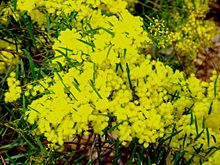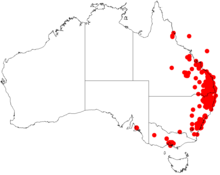Acacia fimbriata, commonly known as the fringed wattle, Brisbane golden wattle, or just the Brisbane wattle, is a species of Acacia that is native to much of the east coast of Australia. It is one of the floral emblems of the city of Brisbane, Queensland.
| Fringed wattle | |
|---|---|

| |
| Scientific classification | |
| Kingdom: | Plantae |
| Clade: | Tracheophytes |
| Clade: | Angiosperms |
| Clade: | Eudicots |
| Clade: | Rosids |
| Order: | Fabales |
| Family: | Fabaceae |
| Subfamily: | Caesalpinioideae |
| Clade: | Mimosoid clade |
| Genus: | Acacia |
| Species: | A. fimbriata
|
| Binomial name | |
| Acacia fimbriata | |
| Synonyms[1] | |
|
List
| |

Description
editAcacia fimbriata, commonly known as the fringed wattle, Brisbane golden wattle,[2] or just the Brisbane wattle,[3] is a shrub or small tree that has an erect or spreading habit and typically grows to a height of 6 to 7 metres (20 to 23 ft) and a width of around 6 m (20 ft).[4] It has angled or flattened branchlets and linear phyllodes with a narrowly elliptic or narrowly lanceolate shape, which are straight or very slightly curved. The phyllodes are 2 to 5 cm (0.8 to 2 in) in length and 2 to 7 mm (0.08 to 0.3 in) wide.[5]
It blooms between July and November producing inflorescences in groups of 8 to 25 located in axillary racemes. The spherical flower heads have a diameter of 3 to 5 mm (0.12 to 0.20 in) and contain 10 to 20 bright yellow or sometimes pale yellow flowers. The glabrous, firmly paper seed pods that form after flowering are flat and straight to slightly curved with straight sides. The pods have a length of 3 to 9.5 cm (1.2 to 3.7 in) and a width of 5 to 8.5 mm (0.20 to 0.33 in).[5] The slightly shiny black seeds are arranged longitudinally in the pods. The seeds have an oblong-elliptical shape and are 4 to 5 mm (0.16 to 0.20 in) in length with a clavate aril.[2]
Taxonomy
editAcacia fimbriata was first formally described by the botanist George Don in 1832 in his book A General History of Dichlamydeous Plants from an unpublished manuscript by Allan Cunningham.[6][7] The type specimen was collected by Cunningham in 1828 from along the Brisbane River.[2]
Distribution
editThe shrub is commonly situated in coastal areas and the adjacent tablelands[2] in New South Wales and Queensland. In New South Wales it is found from Nerriga in the south to Inverell in the west[5] to north of the Queensland border as far as Yeppoon and the Carnarvon National Park.[2] It is often located along rocky streams as a part of Eucalyptus woodland communities growing in rocky and sandy soils[5] or along the fringes of rainforest in more northern areas.[2]
Cultivation
editThe plant is available for cultivation in seed form. It can be gown as a hedge or screening plant but does require adequate water. It is quite hardy, can be planted in a tropical environment and is frost tolerant.[4]
Emblem
editIn October 2023, the flower was added to the city of Brisbane's floral emblems.[8]
Gallery
edit-
A. fimbriata foliage and flowers
-
A. fimbriata foliage and flowers
-
A. fimbriata inflorescence, 7th Brigade Park, Chermside, Queensland.
-
A. fimbriata
-
Inflorescences
-
Immature pods
-
Mature pod.
-
Mature pod and seeds.
See also
editReferences
edit- ^ a b "Acacia fimbriata". Australian Plant Census. Retrieved 29 August 2021.
- ^ a b c d e f "Acacia fimbriata". World Wide Wattle. Western Australian Herbarium. Retrieved 7 August 2019.
- ^ Sato, Kenji (5 October 2023). "Brisbane votes golden wattle — Acacia fimbriata — as city's new floral emblem". ABC News (Australia). Retrieved 4 October 2023.
- ^ a b "Acacia fimbriata Brisbane Golden Wattle". Wattles - genus Acacia. Australian National Botanical Gardens. Retrieved 7 August 2019.
- ^ a b c d "Acacia fimbriata A.Cunn. ex G.Don". PlantNET. Royal Botanic Garden, Sydney. Retrieved 14 September 2018.
- ^ "Acacia fimbriata". APNI. Retrieved 29 August 2021.
- ^ Don, George (1832). A general history of the dichlamydeous plants. London. p. 406. Retrieved 29 August 2021.
- ^ Brisbane City Council. "Symbols used by Council". Brisbane City Council. Retrieved 6 October 2023.